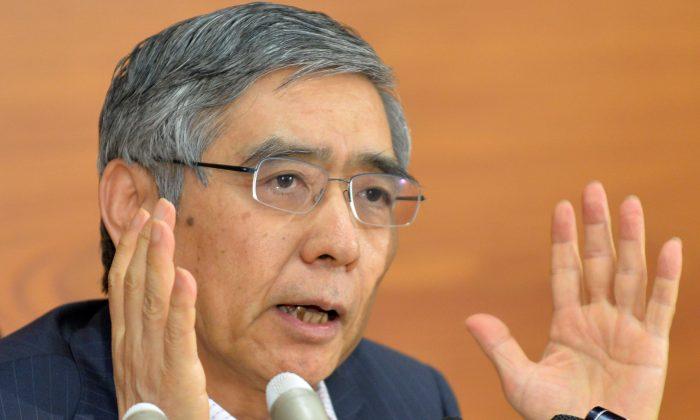NEW YORK— Haruhiko Kuroda, the governor of the Bank of Japan, said on Oct. 10 that he is convinced printing money will defeat deflation and lead Japan back on a growth track.
“The real economy, prices, and expectations—all of them are improving as we intended,” Kuroda said in a speech at the Council on Foreign Relations in New York.
Kuroda started an ambitious quantitative easing program in April after his appointment in February this year. Under the program, the Bank of Japan (BoJ) prints money to buy an equivalent of $71 billion worth of Japanese government bonds (JGBs) every month, a process dubbed quantitative easing.
Japan is printing less than the $85 billion the United States Federal Reserve prints every month. But given that Japan’s economy is less than half the size of the U.S. economy, relatively speaking the program is much bigger.
Kuroda’s plan: Achieve an inflation rate of two percent over the next two years to get consumers to spend, companies to invest, and the economy to grow.
Japan has experienced declining prices ever since an asset bubble burst at the beginning of the 1990s. As a result, the Japanese expect deflation and hoard cash. “It is natural for prices not to increase” when people expect declining prices along the road, Kuroda said.
However, the program has so far “been exerting its intended effect, which is quite encouraging,” Kuroda said in reference to Japan’s rising consumer prices and an economy that grew faster than any of the other developed countries in the second quarter of 2013.
Risky Bet
But like everything in business, this achievement comes at a price.
“You could see a big sell-off [in JGBs] as people migrate out of those assets because we don’t believe that there is a natural buyer out there in this new inflationary environment with bonds at current yields where they are,” said Richard Howard of Hayman Capital, a Texas-based hedge fund in an earlier interview.
Investors want to be compensated for inflation to earn a real return. In order to get that real return, nominal bond yields will have to rise.
Higher yields mean indebted sectors need more cash flow to service the debt. This creates problems for the sectors of the economy, which are highly leveraged, including the Japanese government.
“The problem with trying to create inflation is that debt is going to be harder to service. The hope is that the inflation creates enough nominal growth to enable the higher debt service costs. That makes sense for a portion of the economy that is not highly levered and can afford to service their debts,” explains Howard.
In Howard’s scenario, government debt service will increase much faster than tax receipts, as markets move faster than the broader economy on which tax receipts depend. This vicious spiral could ultimately bankrupt the government, absent further intervention by the central bank.
Kuroda expressed his confidence to keep nominal yields relatively low and increase inflation expectations but there is no historical precedent to support his theory. “We intend to contain as much as possible long-term interest rates from rising,” he said.
“The policymakers who are overseeing this process, they are convinced of the correctness of their views. Lots of experts out there will tell you that a government can never go bankrupt if you have a compliant central bank out there that can always buy your debt. As long as the BoJ cooperates there will never be a problem,” said Howard.
However, more liquidity injected by the BoJ will cause more inflation, further accelerating the vicious circle. Ultimately, this dynamic could lead to a massive sell-off in the Japanese yen and to a re-pricing of bad debt in real terms, thus delivering the economy and the banking system.
No Wage Growth
For now, it’s all blue skies though: The Japanese stock market is up 37 percent this year, consumer prices increased 0.8 percent in August, and the economy grew by 3.8 percent in the second quarter. There is one thing, however, that worries Kuroda and could make a consumer led recovery elusive—wage growth.
Despite low unemployment, base wages in Japan remain stagnant, but Kuroda remains optimistic. “Since we are expecting prices to rise gradually, wages should also rise gradually,” he said.
Victor Sperandeo, a commodities trader and Wall Street veteran, doesn’t think this will happen, because people would rather invest in stocks than build new businesses.
“What people are doing is that they are buying stocks instead of opening businesses and you don’t have businesses starting now. That’s why wages are low,” said Sperandeo. “Wages come from competing businesses paying up for workers. The assumption that wealthy people who make money on stocks and then take that money and do either one of two things with it: Spend it or create businesses is not working, it’s a fallacy.”
Sperandeo thinks the reason people aren’t starting businesses lies within a complex regulatory and tax framework.
“You face high taxes, the cost of unknown regulation, [and] bureaucrats,” Sperandeo said in reference to the issues associated with starting a business. “Take your money, let the BoJ do their money printing, buy stocks you like. They are liquid in seconds. Let those companies send their lobbyists so you don’t have to hire a lobbyist.”
If not, you have to do everything yourself, “You have to work, manage people, manage bureaucrats, and solve problems,” Sperandeo said.





